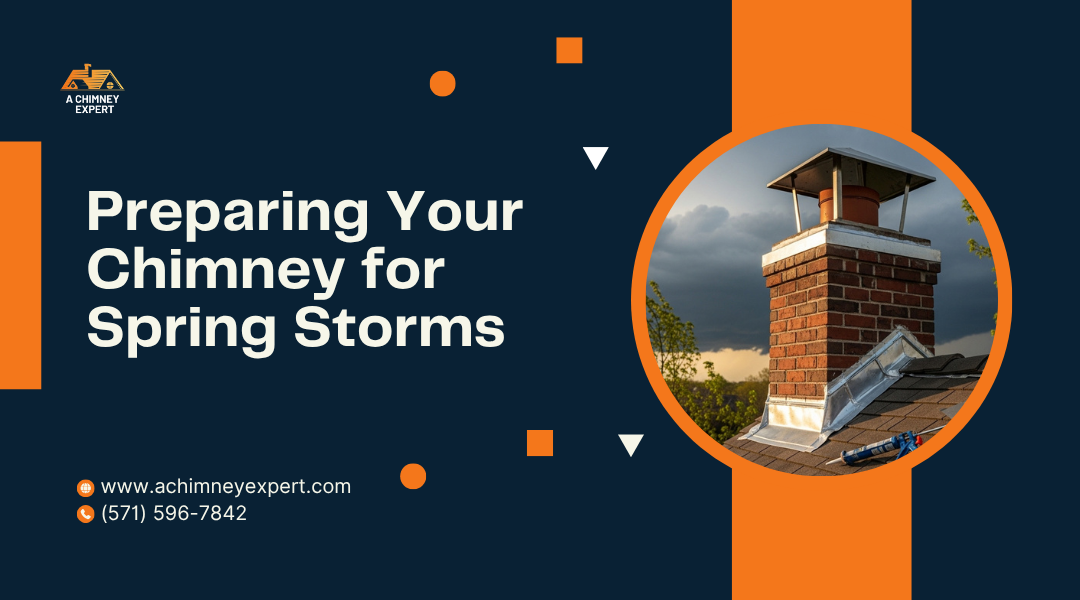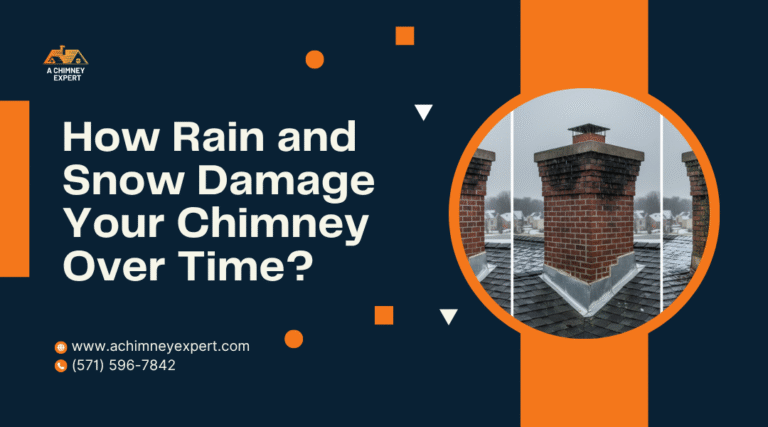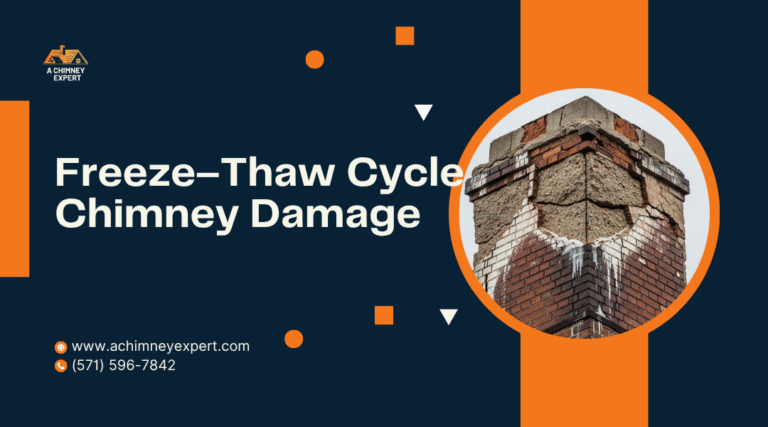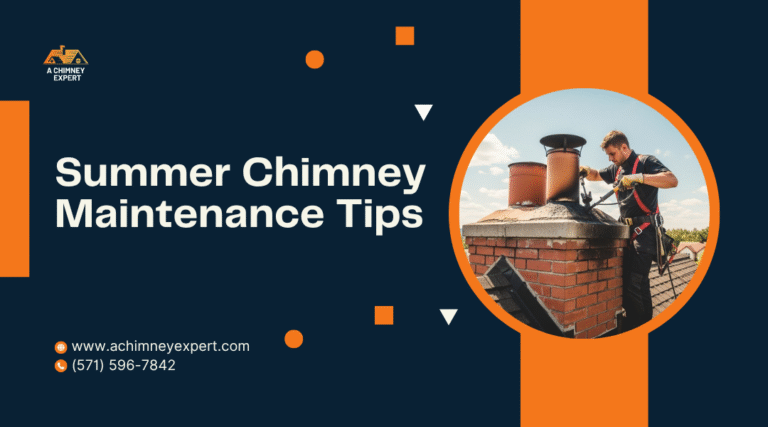Spring storms in Oak Grove can bring heavy rain, strong winds, and sudden temperature changes that test every part of your home—especially your chimney. While it might seem sturdy, your chimney faces constant exposure to moisture and debris that can lead to cracks, leaks, and structural wear. Preparing your chimney before spring storms helps prevent costly water damage and keeps your fireplace system safe and efficient year-round.
When you take time to inspect and maintain your chimney now, you protect your home from leaks, odors, and hidden fire hazards later. A professional inspection after winter reveals any damage caused by freezing temperatures or creosote buildup. Repairing weak spots and sealing your chimney’s exterior ensures it stands strong against the next downpour.
At A Chimney Expert LLC, you get trusted, certified care from a team that understands Virginia’s unpredictable weather. With decades of experience and proven methods, you can count on reliable solutions that keep your chimney in top condition through every season.
Why Spring Storms Pose a Risk to Your Chimney
Spring storms bring a mix of heavy rain, high winds, and sharp temperature changes that can expose weak points in your chimney. These conditions often cause cracks, leaks, and erosion that worsen over time if not addressed quickly. Routine inspection and maintenance help you prevent costly repairs and protect your home’s safety.
Heavy Rain, High Winds, and Sudden Temperature Shifts
Spring weather often combines intense rainfall with strong wind gusts. These forces can loosen mortar joints, shift chimney caps, and push debris into the flue. When wind pressure hits tall chimneys, it can tilt or crack masonry, especially if the structure already shows wear from previous seasons.
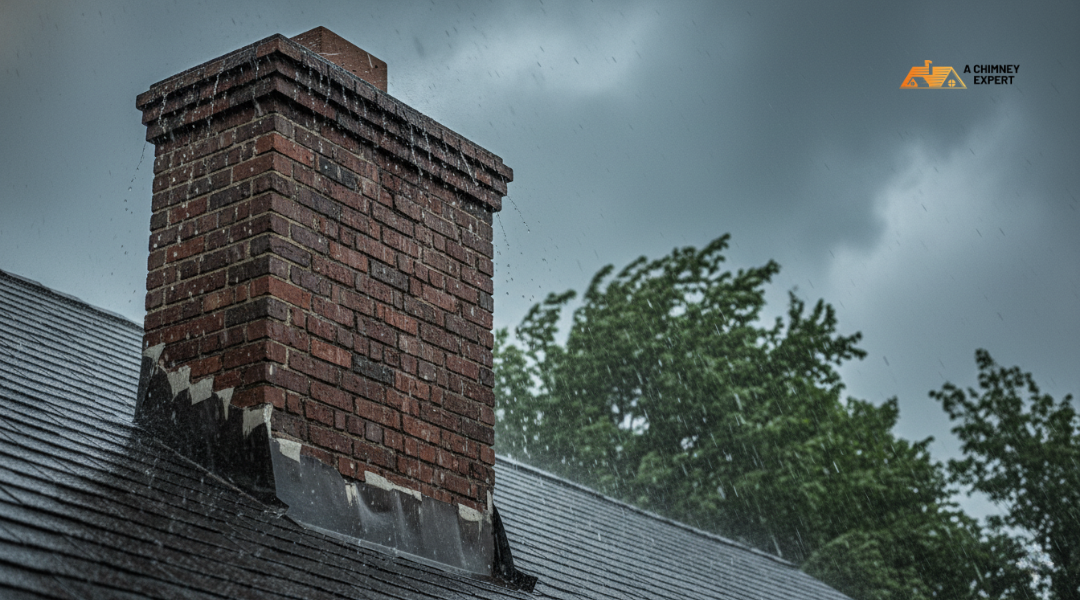
High winds may also dislodge flashing—the metal barrier that seals the gap between the chimney and roof. Once flashing lifts or rusts, water can enter through small openings.
Sudden temperature swings add to the problem. When warm air follows a cold snap, moisture inside the masonry expands and contracts, deepening cracks. Over time, this cycle weakens the chimney’s stability and reduces its ability to vent smoke safely.
How Water Penetration Leads to Long-Term Structural Damage
Water is one of the most damaging elements for masonry chimneys. When rain seeps through cracked crowns, loose mortar, or damaged bricks, it slowly breaks down the internal structure. Moisture trapped inside the brickwork causes spalling, where the surface flakes or chips away.
During cooler nights, that water freezes and expands, widening cracks. This freeze-thaw cycle repeats throughout spring, leading to larger gaps and structural instability.
Even small leaks can result in stains on interior walls, mold growth, or rusted dampers. Over time, unchecked moisture can weaken the chimney base and create unsafe conditions for your fireplace system.
To reduce risk, you can apply a breathable waterproof sealant and ensure your chimney cap and flashing remain intact.
The Connection Between Spring Storms and Post-Winter Chimney Weakness
After winter, your chimney may already have hidden damage from freeze-thaw cycles or ice buildup. Spring storms often expose these weaknesses. Cracked mortar, eroded joints, or a leaning structure can worsen when hit by heavy rain and high winds.
Winter’s cold temperatures make masonry brittle. When spring moisture enters existing cracks, it accelerates deterioration. If your chimney crown or cap suffered winter damage, water can easily enter the flue.
A professional inspection after extreme weather helps you find early signs of trouble. Specialists can check for loose bricks, misaligned caps, and water infiltration before they develop into major structural issues. Regular care keeps your chimney safe and ready for seasonal changes.
Step 1: Schedule a Professional Chimney Inspection After Winter
Cold weather often leaves behind hidden damage that can weaken your chimney’s structure and safety. A professional chimney inspection helps you find cracks, leaks, and moisture problems early so you can fix them before spring storms cause more serious issues.
Identifying Hidden Damage from Snow, Ice, or Freeze–Thaw Cycles
Winter moisture can seep into small openings in your chimney. When temperatures drop, that water freezes and expands, causing materials to crack or shift. This freeze–thaw cycle often leads to loose mortar joints, damaged flue tiles, and weakened bricks.
A certified technician from A Chimney Expert LLC can use specialized tools to check for internal damage that isn’t visible from the ground. They may examine the flue liner, chimney crown, and flashing for signs of water intrusion or corrosion.
Scheduling this inspection soon after winter ensures that any damage caused by snow or ice is discovered before heavy spring rains make it worse. Early detection of these hidden issues helps maintain your chimney’s safety and prevents expensive repairs later.
Checking for Cracks, Leaks, and Brick Deterioration
Even small cracks can allow water to enter your chimney system. Over time, moisture causes spalling, where brick faces flake or fall away. This weakens the structure and may lead to leaks inside your home.
During a professional chimney inspection, the technician checks for:
| Problem Area | What to Look For | Why It Matters |
|---|---|---|
| Mortar Joints | Gaps or crumbling | Allows water entry |
| Flashing | Rust or loose edges | Causes roof leaks |
| Chimney Crown | Cracks or pooling water | Leads to internal damage |
If the inspector finds deterioration, they can recommend waterproofing treatments or minor masonry repairs before the next storm season. Addressing these issues early keeps your chimney dry and structurally sound.
The Importance of Early Detection Before Storm Season Hits
Spring storms bring high winds and heavy rain that can worsen existing chimney problems. If cracks, gaps, or loose bricks remain unfixed, water can penetrate deeper and cause internal rot or mold.
By scheduling your chimney inspection before storm season, you give technicians time to make necessary repairs. This proactive step also ensures your fireplace and venting system operate safely when you need them again.
Early detection saves you time and money by preventing small issues from becoming major structural problems. It also protects your home from moisture damage and improves the long-term durability of your chimney system.
Step 2: Ensure Your Chimney Cap and Crown Are in Top Shape
Keeping your chimney cap and crown in good condition helps prevent water leaks, debris buildup, and structural damage. Proper maintenance reduces the risk of costly repairs and keeps your fireplace system working safely through heavy spring rain and wind.
The Role of Chimney Caps in Blocking Rain and Debris
A chimney cap is a metal cover that sits on top of the flue. It acts as a shield against rain, snow, and falling debris. Without it, water can run directly into the chimney, leading to rusted dampers, cracked liners, and interior leaks.
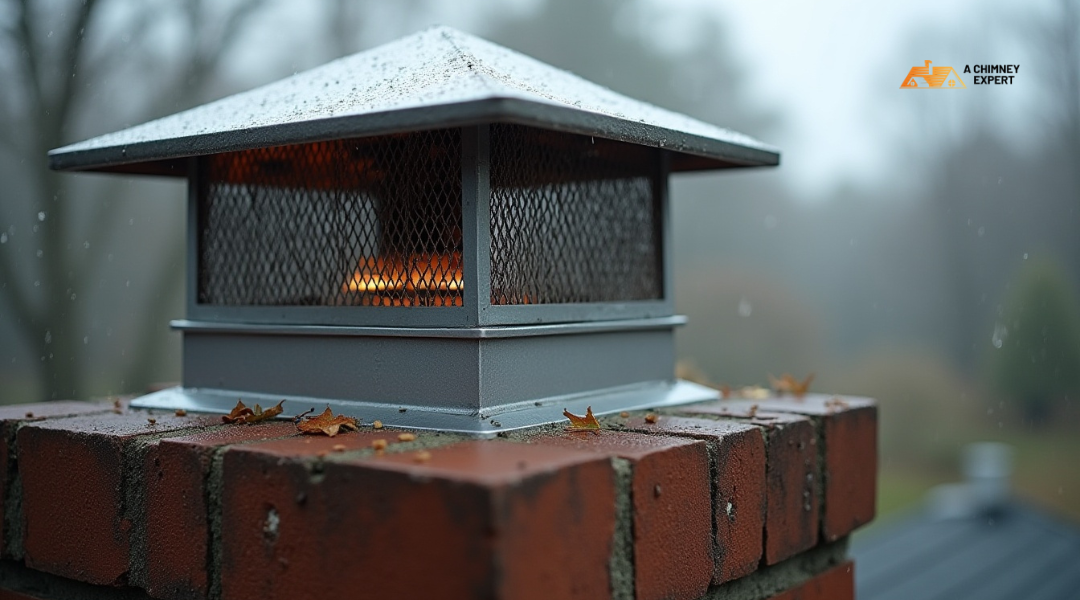
Caps also block leaves, twigs, and small animals from entering and clogging the flue. Many models include a mesh screen that prevents birds and rodents from nesting inside.
When choosing a cap, look for stainless steel or copper materials. These resist corrosion and last longer than basic galvanized steel. Proper installation ensures the cap fits tightly and directs water away from the flue opening.
Adding a cap is one of the simplest ways to protect your chimney system from moisture and blockages year-round.
Common Signs of Cap or Crown Damage
Inspect your chimney at least once a year, especially after strong storms. Visible rust, loose fittings, or missing sections on the cap are signs it needs attention. If you notice water stains on your ceiling or fireplace walls, the cap or crown may not be sealing properly.
The chimney crown, the concrete or cement slab at the top, can crack or flake over time. Small cracks allow water to seep in and freeze, causing larger fractures later. Moss or dark stains on the crown often indicate trapped moisture.
Use binoculars or hire a professional to check for:
- Chips or crumbling edges
- Gaps between the crown and chimney brick
- Rust streaks running down the masonry
Early detection helps you fix small problems before they spread deeper into the chimney structure.
When to Repair or Replace for Maximum Weather Protection
Minor issues like hairline cracks or light rust can often be sealed with waterproof coatings or silicone-based sealants. These materials block moisture and extend the life of the crown or cap.
If the crown has deep cracks, missing chunks, or separation from the brickwork, replacement is the safer option. A new crown should be made of reinforced concrete with a slight slope to shed rainwater. It should also extend at least two inches past the chimney edge for proper runoff.
For chimney caps, replace any that are bent, corroded, or no longer secure. A professional from A Chimney Expert LLC can install a new cap sized to your flue and anchored to withstand high winds.
Timely repair or replacement ensures your chimney stays dry, stable, and ready for the next round of spring storms.
Step 3: Inspect Flashing and Seal Weak Points
Check the metal flashing around your chimney to prevent leaks during heavy spring rain. Damaged or loose flashing allows water to enter the roof system, leading to rot, mold, and interior stains. Applying professional waterproofing and keeping up with regular maintenance helps protect your chimney and roof from moisture intrusion.
Why Loose or Corroded Flashing Leads to Leaks
Flashing forms the watertight barrier between your chimney and roof. When it becomes loose, bent, or corroded, water can slip behind it and seep into the attic or walls.
You may notice rust spots, cracked sealant, or lifted edges—all signs that water is already finding a way in. Even a small gap can cause a steady leak that damages insulation and ceiling materials.
During your inspection, look for:
- Discoloration or stains near the chimney base
- Cracked caulk or missing nails
- Warped flashing that no longer lies flat
Fixing these issues early prevents larger repairs later. Replacing damaged flashing or resealing joints with roofing cement ensures a tight, weather-resistant seal.
How Professional Waterproofing Prevents Moisture Intrusion
A professional chimney technician can apply a breathable waterproof sealant that blocks water from entering while allowing trapped moisture to escape. This treatment protects both the flashing and the masonry surfaces.
Unlike basic caulks, these coatings resist UV rays and temperature changes that cause cracking. Waterproofing also reinforces the seams where flashing meets brick or stone, reducing the risk of chimney leaks during spring storms.
At A Chimney Expert LLC, technicians often use elastomeric or silicone-based sealants for long-lasting flexibility. These materials expand and contract with the roof, keeping your flashing sealed even in shifting weather conditions.
The Value of Annual Flashing Maintenance for Storm Durability
Inspecting and maintaining your chimney flashing each year helps your roof withstand strong winds and heavy rain. Seasonal checks let you spot corrosion, nail loosening, or broken mortar before they turn into leaks.
A simple maintenance schedule might include:
| Task | Frequency | Purpose |
|---|---|---|
| Visual inspection | Every spring | Catch early signs of wear |
| Resealing joints | As needed | Maintain watertight protection |
| Professional check | Annually | Ensure structural integrity |
Routine care extends the lifespan of both your chimney and roof, keeping your home dry and secure through unpredictable spring weather.
Step 4: Clear and Clean the Chimney Flue
Keeping your flue clear protects your home from smoke backup, moisture damage, and fire hazards. Regular cleaning removes soot, creosote, and debris that restrict airflow and cause odor or efficiency problems during damp spring weather.
Removing Debris and Nesting Material Before Storms Arrive
During spring, birds, squirrels, and other small animals often build nests inside unused chimneys. Leaves, twigs, and loose debris can also collect in the flue and block airflow. Before heavy rain and wind arrive, inspect the chimney using a flashlight or mirror to check for buildup.
Use a chimney brush, vacuum, and drop cloth to remove soot and debris safely. Wear gloves and a dust mask to avoid inhaling fine particles. If you find a nest or blockage deep inside the flue, it’s best to contact a professional chimney sweep for removal.
A clear flue allows smoke and gases to exit freely, reducing the chance of backdrafts or smoke entering your home. This step also prevents debris from becoming wet and compacted during storms, which can make later cleaning more difficult.
How Clogged Flues Cause Draft and Moisture Problems
A clogged or partially blocked flue disrupts the draft that pulls smoke and gases out of your fireplace. When airflow weakens, smoke can spill into living areas or linger in the chimney, leading to poor combustion and excess moisture buildup.
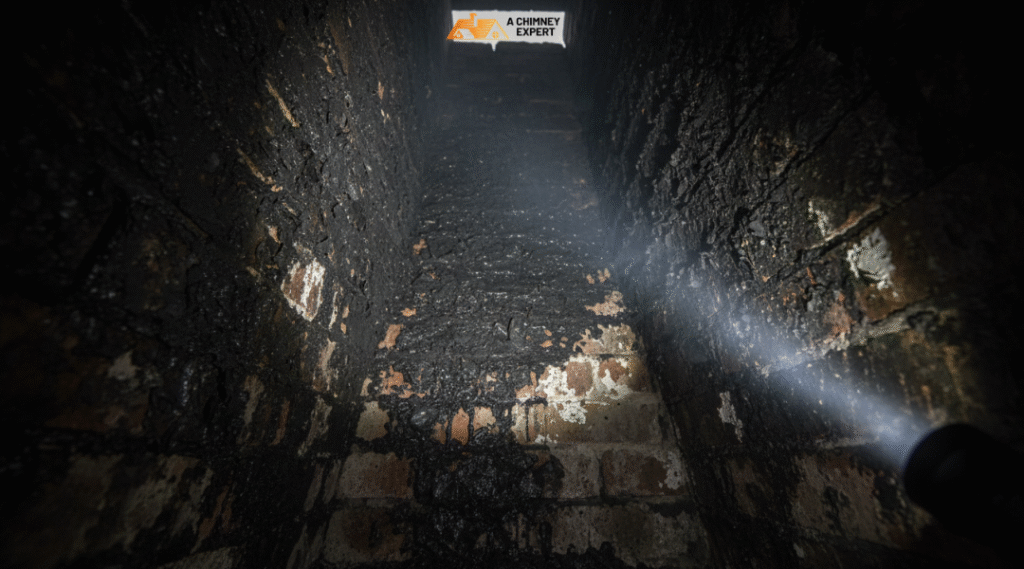
Moisture can mix with soot and creosote to form a sticky residue that damages the flue liner. Over time, this can cause corrosion or cracks that let water seep through masonry walls. You may notice musty odors, white staining (efflorescence), or peeling chimney paint—all signs of trapped moisture.
To maintain a steady draft, clean the flue thoroughly and check that the damper opens and closes smoothly. Proper ventilation keeps humidity from settling in the chimney and helps your fireplace perform safely and efficiently.
Why Cleaning Improves Efficiency and Prevents Odor Issues in Humid Weather
A clean chimney flue improves how efficiently your fireplace burns fuel. When soot and creosote are removed, air moves freely, allowing wood or gas to burn hotter and cleaner. This means less smoke, fewer emissions, and better heat output.
In humid spring weather, leftover residue inside a dirty flue can absorb moisture and produce unpleasant odors. These smells often spread through the house, especially when air pressure changes during storms.
By cleaning the flue and removing buildup, you reduce odor problems and prevent damp soot from releasing harmful particles. Schedule annual cleaning and inspection with A Chimney Expert LLC to keep your system safe, efficient, and ready for changing weather conditions.
Step 5: Reinforce Masonry and Apply Waterproofing Treatments
Moisture can weaken your chimney’s structure by seeping into tiny cracks and deteriorating mortar. Reinforcing the masonry and applying the right waterproofing treatment helps prevent water damage, extend the chimney’s life, and reduce the need for costly chimney repair later.
How Masonry Absorbs and Retains Rainwater
Brick and mortar are porous materials. When it rains, water can soak into small gaps and cracks, especially where cracked or deteriorating mortar exists. Once trapped, moisture expands and contracts with temperature changes, which can cause further cracking and spalling.
Over time, this cycle weakens the chimney’s surface and can lead to leaks inside your home. You may notice white stains called efflorescence—a sign that water is moving through the masonry and depositing salts on the surface.
To reduce absorption, you can repoint damaged joints and replace loose bricks. These repairs create a solid base before adding waterproofing products. Proper drainage around the crown and flashing also helps prevent water from pooling or running down the chimney face.
Using Vapor-Permeable Sealants to Protect Brick and Mortar
A vapor-permeable sealant allows moisture inside the masonry to escape while blocking new water from entering. This balance is important because trapping moisture can cause internal damage and shorten the chimney’s lifespan.
Choose a silane- or siloxane-based sealer, which penetrates deep into the brick and mortar instead of forming a surface film. These products protect against rain and snow while letting the chimney “breathe.”
Before applying the sealant, clean the chimney with a stiff brush or low-pressure washer to remove dirt and debris. Apply the product evenly with a sprayer or roller, following the manufacturer’s directions. Two light coats often provide better coverage than one heavy coat.
Benefits of Professional Waterproofing by CSIA-Certified Technicians
Hiring a CSIA-certified chimney technician ensures that your chimney gets inspected, repaired, and sealed correctly. Professionals can identify hidden cracks, gaps in flashing, or areas of deteriorating mortar that you might miss.
They use commercial-grade waterproofing products that last longer and resist UV damage. A professional may also test the masonry’s absorption rate before selecting the right treatment.
In addition, certified technicians follow safety standards and can combine waterproofing with other services, such as chimney repair or crown sealing. This comprehensive approach keeps your chimney structurally sound and ready to handle heavy spring storms.
Step 6: Check for Proper Drainage and Roof Integration
Water that pools or drains incorrectly near your chimney can cause leaks, masonry damage, and roof deterioration. Proper drainage, flashing, and roof slope work together to move water away from the chimney and prevent moisture from reaching your home’s structure.
Ensuring Downspouts and Gutters Direct Water Away from the Chimney
Keep gutters and downspouts clear so rainwater flows freely. Blocked gutters can overflow and send water toward the chimney base, allowing moisture to seep into mortar joints or flashing seams.
Inspect the gutter alignment. It should slope slightly—about ¼ inch per 10 feet—toward the downspouts. This small pitch helps water move efficiently.
Add gutter extensions or splash blocks to direct runoff several feet away from the foundation and chimney area. If you notice water stains or erosion near the chimney, the drainage path may need adjustment.
During heavy storms, check for leaks at gutter joints and seams. Seal small gaps with exterior-grade caulk or replace damaged sections. Clean gutters at least twice a year, especially before spring storms, to keep water from backing up onto the roof.
The Overlooked Role of Roof Slope and Flashing Placement
Your roof’s slope and the way flashing is installed around the chimney determine how well water drains. A roof that slopes too gently can let water pool near the chimney, while a steep slope without proper flashing can cause runoff to push under shingles.
Flashing should form a tight, layered barrier around the chimney base. Step flashing along the sides and counter flashing embedded in the chimney masonry work together to seal gaps.
If your roof includes a chimney cricket or saddle, it should slope at least 1.5 times steeper than the main roof to divert water. This small structure helps prevent standing water and debris buildup.
Examine flashing for rust, cracks, or lifted edges. Even minor damage can allow leaks during spring storms. Replace worn flashing promptly to maintain a watertight seal between the roof and chimney.
Coordinating with Roofing Professionals for Full Protection
A chimney’s drainage and roof integration often require both chimney and roofing expertise. You can inspect visible areas, but a professional roofer can identify hidden weak points that lead to leaks.
Schedule a joint inspection with a certified chimney sweep and a licensed roofer. They can evaluate how the flashing, shingles, and roof slope interact. This coordinated approach ensures that both systems protect each other.
Ask the roofer to check for proper sealing under shingles near the chimney and confirm that the roof deck remains solid. If needed, they can adjust flashing placement or install a cricket to improve drainage.
Professional coordination helps prevent recurring leaks and reduces long-term repair costs. It also ensures your chimney and roof remain stable and watertight during heavy spring rainfall.
Why Homeowners in Oak Grove Choose A Chimney Expert LLC
Homeowners in Oak Grove trust A Chimney Expert LLC because the company combines decades of local experience, certified professionals, transparent service, and dependable response times. Each service focuses on safety, proper chimney maintenance, and long-term protection against Virginia’s changing weather.
45+ Years of Local Experience with Virginia’s Weather Conditions
You face heavy rain, humidity, and seasonal storms that can wear down your chimney system. With more than 45 years of experience in Oak Grove and surrounding areas, A Chimney Expert LLC understands how these conditions affect masonry, metal components, and flue systems.
Their team uses this local knowledge to identify issues early. For example, they know where water intrusion often starts and how freeze-thaw cycles damage mortar joints.
Common weather-related chimney concerns include:
- Rust on chase covers and flashing
- Cracked crowns and deteriorated mortar
- Moisture inside the firebox or flue
By tailoring inspections and repairs to Virginia’s climate, you receive service that prevents recurring problems rather than temporary fixes.
Fully Licensed, Insured, and CSIA-Certified Technicians
You want assurance that your chimney work meets safety and building standards. A Chimney Expert LLC employs CSIA-certified technicians who follow industry best practices for inspection, cleaning, and repair.
The company holds full licensing and insurance in Virginia, protecting both you and your property during every job. This coverage ensures that each service—whether it’s a chimney sweep, chase cover replacement, or flue repair—is performed safely and legally.
Technicians stay updated on NFPA 211 and other relevant codes. They use approved materials and methods that maintain your chimney’s efficiency while reducing fire and carbon monoxide risks.
This level of certification and compliance gives you confidence that your chimney maintenance is handled by qualified professionals.
Honest Assessments and Long-Term Maintenance Plans
You receive clear evaluations instead of unnecessary upsells. Technicians explain inspection results in plain language, showing photos and describing what each issue means for your system’s safety and performance.
A Chimney Expert LLC builds maintenance plans that fit your home’s age, fireplace type, and usage. These plans often include:
- Annual inspections and cleanings
- Waterproofing and sealing recommendations
- Timely repair schedules for worn components
By following a structured plan, you reduce emergency repair costs and extend your chimney’s lifespan. The focus stays on prevention and reliable performance through every season.
Quick, Reliable Service Backed by Family-Owned Integrity
When storms or leaks occur, you need quick help from a team that values your time. A Chimney Expert LLC responds promptly to inspection and repair requests, minimizing downtime and preventing further damage.
As a family-owned business, they maintain consistent communication and dependable scheduling. You work directly with local professionals who understand Oak Grove homes and treat each project with care.
Their reputation for reliability comes from consistent follow-through—arriving when promised, completing work on schedule, and ensuring your chimney system remains safe and functional year-round.

